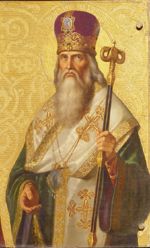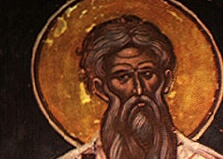Tarasios of Constantinople facts for kids
Quick facts for kids SaintTarasios of Constantinople |
|
|---|---|

Icon of Saint Tarasius, Patriarch of Constantinople (Johann Conrad Dorner, 1848–1852)
|
|
| Hierarch; Bishop and Confessor | |
| Born | c. 730 Constantinople (modern-day Istanbul, Turkey) |
| Died | 25 February 806 Constantinople (modern-day Istanbul, Turkey) |
| Venerated in | Eastern Orthodox Church Catholic Church |
| Canonized | Pre-Congregation |
| Feast | February 18th (Catholic Church) (General Roman Calendar) February 25th (Eastern Orthodox Churches) |
| Attributes | Vested as a bishop with omophorion often holding a Gospel book with his right hand raised in blessing |
| Saint | |
|---|---|
| Ecumenical Patriarch of Constantinople | |
| Enthroned | 25 December 784 |
| Reign ended | 25 February 806 |
| Predecessor | Paul IV |
| Successor | Nikephoros I |
| Personal details | |
| Denomination | Chalcedonian Christianity |
Saint Tarasios (born around 730, died February 25, 806) was a very important leader in the Christian Church. He was the Ecumenical Patriarch of Constantinople, which is like being the main bishop for a big part of the Eastern Christian world. He held this important job from December 25, 784, until he passed away.
Contents
Early Life and Career
Tarasios was born and grew up in the city of Constantinople, which is now called Istanbul in Turkey. His father was a high-ranking judge, and Tarasios was connected to important families in the city.
He started his career working for the government. He became a senator and later worked as a special secretary for the Emperor Constantine VI and his mother, Empress Irene.
Becoming Patriarch
When the previous Patriarch, Paul IV, decided to retire to a monastery, he suggested that Tarasios should take his place. This was unusual because Tarasios was not a priest; he was a regular person working in the government.
However, Tarasios was chosen by Empress Irene in 784. He was known for supporting the use of icons in churches. He also showed that he was willing to follow the emperor's orders, as long as they did not go against his faith.
Tarasios did not want the job at first. He only agreed if the Church could become united again with Rome and other Christian leaders. He also wanted a special meeting, called a council, to discuss the issue of icons. Before he could become Patriarch, Tarasios was made a deacon, then a priest, and finally a bishop.
The Seventh Ecumenical Council
Before Tarasios became Patriarch, he made sure that icons would be brought back into the church. Icons are religious images that Christians honor. Empress Irene, with Tarasios's help, invited Pope Hadrian I from Rome to send representatives to a new council. The goal was to fix the problems caused by people who did not want icons in churches.
The Pope agreed to send his representatives. The council first met in Constantinople in August 786. However, some soldiers who were against icons caused trouble and broke up the meeting. The Pope's representatives quickly left for Rome.
After the soldiers were removed from the city, the representatives met again in Nicaea in September 787. This meeting is known as the Second Council of Nicaea. Tarasios led the council. At this council, they decided that honoring icons was allowed and important for the Church. Tarasios tried to be fair to those who had been against icons, but some people, like Theodore the Studite, disagreed with his approach.
Challenges and Later Years
About ten years later, Tarasios faced another challenge. In 795, Emperor Constantine VI decided to divorce his wife. Tarasios reluctantly allowed this to happen. Many monks were very upset by the Patriarch's decision.
The leaders of the protest, Abbot Plato and his nephew Theodore the Studite, were sent away. But the protests continued. People were especially angry at Tarasios for allowing the emperor to marry another woman, even though Tarasios himself refused to perform the wedding. Because of strong pressure from Theodore, Tarasios eventually removed the priest who had performed the emperor's second marriage from his duties.
Tarasios continued to serve as Patriarch under the next emperors, Irene and Nikephoros I. Some people criticized him for being too tolerant of certain practices. However, his ability to work with different rulers helped him stay in his important position until he died. His example also influenced later choices of non-priests to become Patriarchs.
Why Tarasios is Remembered
Even though some people later thought Tarasios was too willing to follow the emperor's wishes, he is still honored as a saint in the Eastern Orthodox Churches. He is remembered for defending the use of icons and for working hard to bring peace and unity to the Church.
His special day, called a feast day, is celebrated on February 25 by Eastern Orthodox Christians. It is celebrated on February 18 by Catholics.
Images for kids
-
Icon of Saint Tarasius, Patriarch of Constantinople (Johann Conrad Dorner, 1848–1852)
-
Icon of the Seventh Ecumenical Council (17th century, Novodevichy Convent, Moscow)




